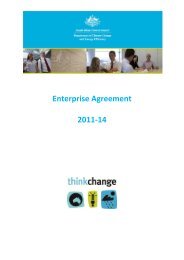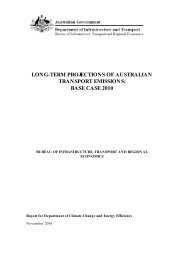Implications of Climate Change for Australia's World Heritage ...
Implications of Climate Change for Australia's World Heritage ...
Implications of Climate Change for Australia's World Heritage ...
You also want an ePaper? Increase the reach of your titles
YUMPU automatically turns print PDFs into web optimized ePapers that Google loves.
2. IMPORTANT ASPECTS OF CLIMATE CHANGE<br />
FOR WORLD HERITAGE PROPERTIES<br />
In its Fourth Assessment Report 2007, the United Nations IPCC found that ‘warming <strong>of</strong> the climate system is unequivocal’<br />
and that levels <strong>of</strong> greenhouse gas emissions such as carbon dioxide, methane and nitrous oxide in the atmosphere have<br />
increased markedly as a result <strong>of</strong> human activities since 1750. These changes have altered the energy balance in the<br />
atmosphere, which results in a warming effect.<br />
The IPCC report found, <strong>for</strong> example, that more intense and longer droughts have been observed over wider areas since<br />
the 1970s, particularly in the tropics and subtropics. Increased drying linked with higher temperatures and decreased<br />
precipitation has contributed to changes in drought regimes. <strong>Change</strong>s in sea surface temperatures, wind patterns, and<br />
decreased snowpack and snow cover have also been linked to changes in drought occurence.<br />
For the next two decades, a global warming <strong>of</strong> about 0.2 °C per decade is projected <strong>for</strong> a range <strong>of</strong> emissions scenarios.<br />
Even if the concentrations <strong>of</strong> all greenhouse gases and aerosols had been kept constant at year 2000 levels, a further<br />
warming <strong>of</strong> about 0.1 °C per decade would be expected.<br />
Rising sea levels and increased acidification <strong>of</strong> the oceans are also likely. From 1993 to 2003, global mean sea level has been<br />
rising at a rate <strong>of</strong> around 3 mm/yr (Bind<strong>of</strong>f et al. 2007). Thermal expansion <strong>of</strong> the oceans and widespread melting <strong>of</strong> land ice<br />
will increase global sea level rise.<br />
2.1 Australian impacts<br />
Australia’s average surface temperature has increased by about 0.7 °C since 1900 (IPCC 2007). Recent Australian<br />
projections <strong>of</strong> climate change provide further details to those provided in the IPCC Fourth Assessment Working Group II<br />
report. In its <strong>Climate</strong> change in Australia: Technical report 2007, CSIRO and the Bureau <strong>of</strong> Meteorology (BOM) concluded<br />
‘that by 2030, temperatures will rise by about 1 °C over Australia—a little less in coastal areas and a little more inland. Later<br />
in the century, warming depends on the extent <strong>of</strong> greenhouse gas emissions. If emissions are low, warming <strong>of</strong> between<br />
1 °C and 2.5 °C is likely by around 2070, with a best estimate <strong>of</strong> 1.8 °C. Under a high emission scenario, the best estimate<br />
<strong>of</strong> warming is 3.4 °C, with a range <strong>of</strong> 2.2 °C to 5 °C. Rainfall projections <strong>for</strong> later in the century are more dependent on<br />
greenhouse gas emissions. Under a low emissions scenario in 2070, the best estimate <strong>of</strong> rainfall decrease is 7.5%. Under a<br />
high emission scenario, the best estimate is a decrease <strong>of</strong> 10%.’<br />
Rainfall patterns are expected to change, with northern Australia likely to receive more rainfall, and southern and southeastern<br />
Australia likely to receive less. Seasonal patterns <strong>of</strong> falls are also likely to change. Annual average rainfall and<br />
streamflows are likely to decrease in southern Australia during winter and spring. Rainfall projections <strong>for</strong> later in the century<br />
are more dependent on greenhouse gas emissions. Under a low emission scenario in 2070, the best estimate <strong>of</strong> rainfall<br />
decrease is 7.5%. Under a high emission scenario, the best estimate is a decrease <strong>of</strong> 10%. Water supply and quality are<br />
likely to be affected by higher temperatures, increased evaporation rates, and changes in amount and patterns <strong>of</strong> rainfall.<br />
As a result <strong>of</strong> altered seasonality or reduced precipitation together with increased evaporation, water security problems will<br />
intensify in southern and eastern Australia. For example, annual streamflow in the Murray Darling Basin is likely to fall 10 to<br />
25% by 2050 and 16 to 48% by 2100.<br />
While there will be more dry days and other seasonal changes, when it does rain, rainfall is likely to be more intense.<br />
<strong>Climate</strong> change projections indicate that there is a likelihood <strong>of</strong> more extreme weather events (i.e. heavy rainfall and hail,<br />
flash flooding, and strong winds) and an increase in more intense tropical cyclones. Extreme weather events are likely to<br />
affect most <strong>of</strong> Australia’s <strong>World</strong> <strong>Heritage</strong> values, both cultural and natural. Extreme weather events may result in irreversible<br />
changes to geological and geomorphologic values. There<strong>for</strong>e, important cultural sites such as Aboriginal middens, sea<br />
cave deposits, rock art and cave art sites, which rely on the integrity <strong>of</strong> their underlying land<strong>for</strong>ms (i.e. geological and<br />
geomorphologic values), are also likely to be affected.<br />
9






